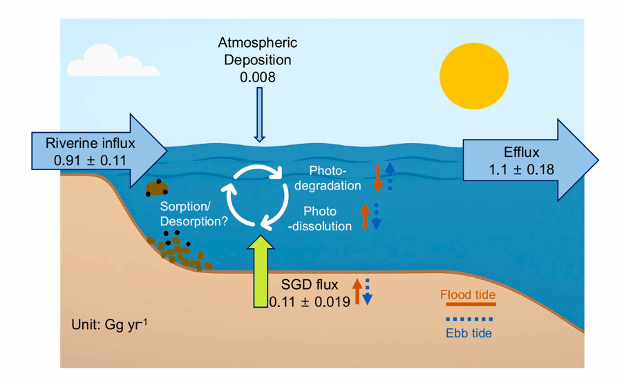Abstract
Estuaries are essential for the ocean's mass balance of terrestrial dissolved organic matter (DOM). Dissolved black carbon (DBC) constitutes the largest known persistent fraction of DOM in marine environments. However, the alterations of DBC during its transport through estuaries remain largely unknown. In this study, we conducted six sampling cruises across three estuaries in China, which varied in size, tidal patterns, and hydrological conditions. We measured DBC concentrations in both the overlying water and sediment porewater. Our results indicated that DBC input occurred during flood tides, whereas DBC removal was observed during ebb tides. Modeling results and laboratory experiments suggest that photodegradation and photo-dissolution were not the primary mechanisms influencing these patterns; instead, variations in submarine groundwater discharge (SGD) of DBC may account for the observed flood-ebb-related fluctuations. Additionally, we found a higher internal accumulation of DBC during the lower runoff period in the three estuaries, which could be related to the longer flushing time. We estimated that SGD-derived DBC flux accounted for ∼12% of DBC discharged from the Jiulong River to the estuary, and represented ∼16–23% of riverine DBC discharge on a global scale. Our study provides new insights into the flood-ebb-tides-related DBC transport in estuaries, which should be considered in future studies of other DOM components in the estuarine region. Furthermore, our study underscores the significance of SGD flux in the transport of terrestrial DOM to the ocean, highlighting the need for its incorporation into the global budget of terrestrial organic matter.

Zhao, W., Bao, H., Peng, L., Du, M., Li,K., Zhan, X., et al. (2025). Transport ofdissolved black carbon in three estuaries inChina: Roles of flood‐ebb tides and submarine groundwater discharge. Global Biogeochemical Cycles, 39, e2025GB008532.
https://doi.org/10.1029/2025GB008532